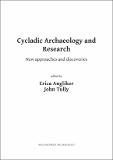Files in this item
The Cyclades in the late antique period : churches, networks and Christianization
Item metadata
| dc.contributor.author | Sweetman, Rebecca Jane | |
| dc.contributor.author | Devlin, Alice | |
| dc.contributor.author | Iliou, Nefeli Piree | |
| dc.contributor.editor | Morais Angliker, Erica | |
| dc.contributor.editor | Tully, John | |
| dc.date.accessioned | 2020-04-30T23:35:13Z | |
| dc.date.available | 2020-04-30T23:35:13Z | |
| dc.date.issued | 2018-05-01 | |
| dc.identifier | 247035796 | |
| dc.identifier | 8e533c41-a836-4bdf-9148-822d6193c99f | |
| dc.identifier | 85113976510 | |
| dc.identifier.citation | Sweetman , R J , Devlin , A & Iliou , N P 2018 , The Cyclades in the late antique period : churches, networks and Christianization . in E Morais Angliker & J Tully (eds) , Cycladic Archaeology and Research : New Approaches and Discoveries . Archeopress , Oxford , pp. 215-238 . | en |
| dc.identifier.isbn | 9781784918095 | |
| dc.identifier.isbn | 9781784918101 | |
| dc.identifier.other | ORCID: /0000-0003-2012-1021/work/60195844 | |
| dc.identifier.uri | https://hdl.handle.net/10023/19872 | |
| dc.description.abstract | While new research on the Cyclades in the Roman period is challenging traditional ideas of the islands as pirate infested backwaters, little is known about them in the Late Antique period (c. 400-700 C.E.); in fact they have been largely written off as too provincial by ancient and contemporary historians. Some 41 Late Antique churches are known from 12 islands, but the synthesis and contextualization of this data has been lacking. Consequently, detailed analysis of Christianization of the East Mediterranean is restricted by a significant gap in the evidence. Scattered data from the Cyclades suggest that they were Christianized earlier than many of the surrounding areas. Other than the Christian catacombs on Melos (1st -4th century), there is literary evidence of an early and energetic Christian community on the islands. For example, some of the islands had early Bishoprics like Amorgos and Santorini. A number of Cycladic bishops also attended the early Ecumenical councils (Bishops from Paros and Naxos attended the 3rd and 4th Councils). Excavations at church of Panagia Ekatontapyliani, Paroikia, Paros, indicate a 4th century foundation, and literary sources tie its establishment to Agia Eleni of the Imperial family. This positive data is bolstered by recent research on surrounding areas, such as the Peloponnese and Crete, which provides clear indications that the Cyclades were conduits for Christianization in the Aegean. However, the processes of how and why this was the case were unknown in part because of the skewed perceptions (often from an Imperial top-down view) and the difficulties of synthesizing the data from the islands. To address this issue, we undertook an architectural and topographic survey of the churches to understand how Christianity was adopted on the islands. It became clear that locations were chosen to draw on tradition and memory to help peacefully situate the new religion in the community. This analysis, combined with a study of the architecture and excavation data (including mortuary and epigraphic) sheds light on the diverse local communities as well as agents of conversion. Rather than insularity, the innovative aspects of church building and early conversion indicate the receptiveness to new ideas on the part of island communities. Altogether, this paper provides an original synthesis of the Late Antique Cyclades from the perspective of the islands themselves which highlights their vibrancy, innovativeness and important roles they played on network routes in the Aegean. | |
| dc.format.extent | 18641997 | |
| dc.language.iso | eng | |
| dc.publisher | Archeopress | |
| dc.relation.ispartof | Cycladic Archaeology and Research | en |
| dc.subject | CC Archaeology | en |
| dc.subject.lcc | CC | en |
| dc.title | The Cyclades in the late antique period : churches, networks and Christianization | en |
| dc.type | Book item | en |
| dc.contributor.sponsor | The Leverhulme Trust | en |
| dc.contributor.sponsor | Carnegie Trust | en |
| dc.contributor.institution | University of St Andrews. School of Classics | en |
| dc.contributor.institution | University of St Andrews. Centre for Ancient Environmental Studies | en |
| dc.contributor.institution | University of St Andrews. Office of the Principal | en |
| dc.contributor.institution | University of St Andrews. St Andrews Institute of Medieval Studies | en |
| dc.date.embargoedUntil | 2020-05-01 | |
| dc.identifier.url | http://www.archaeopress.com/Public/displayProductDetail.asp?id=%7B819F23DC-0616-4B1B-B5FB-C093D772FC07%7D | en |
| dc.identifier.grantnumber | MRF-2015-036 | en |
| dc.identifier.grantnumber | 70163 | en |
This item appears in the following Collection(s)
Items in the St Andrews Research Repository are protected by copyright, with all rights reserved, unless otherwise indicated.

